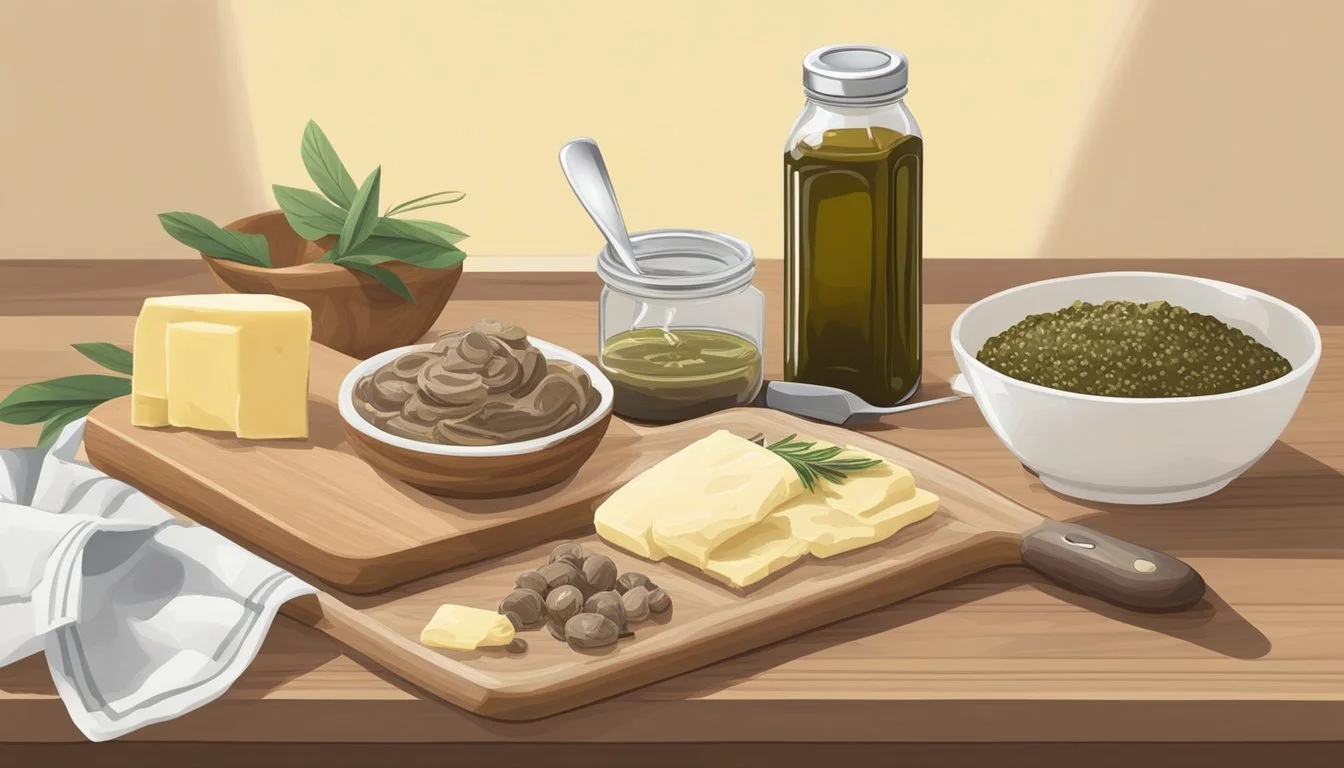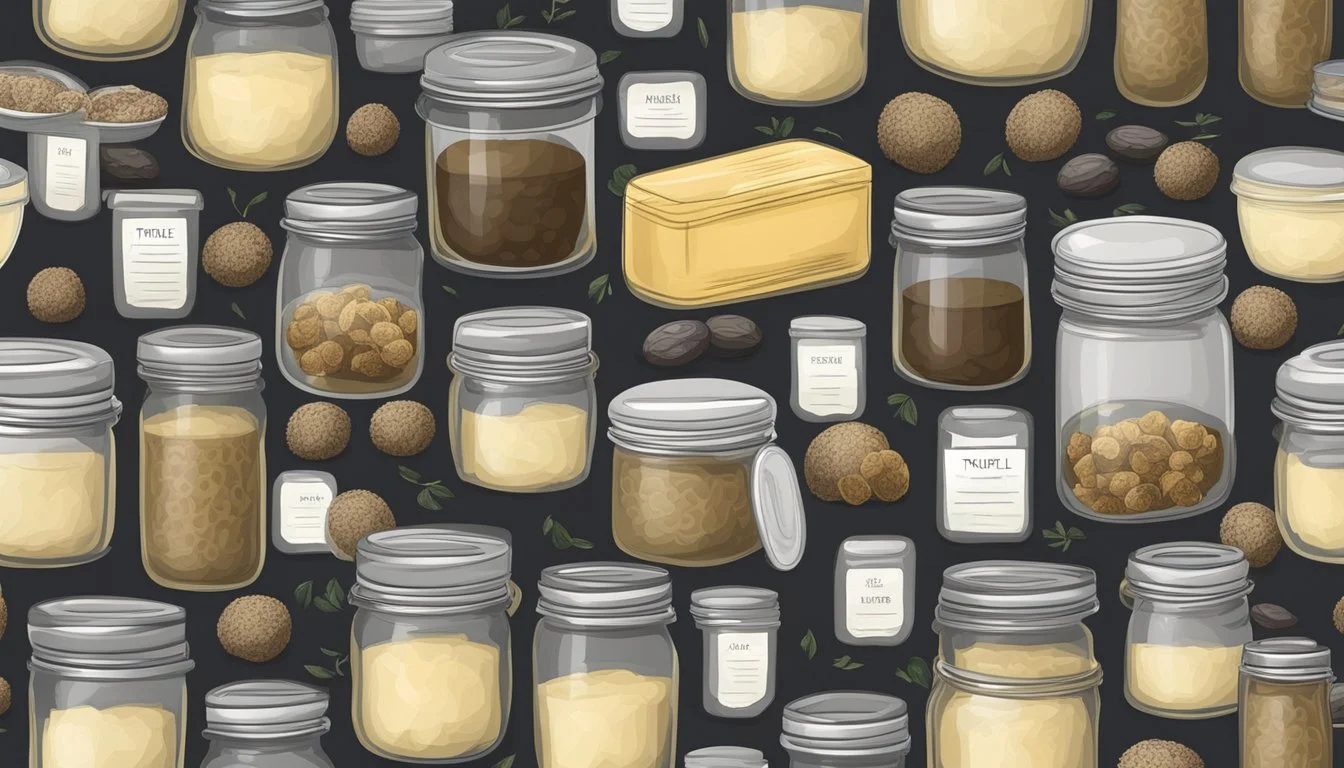Truffle Butter Substitutes
Top Alternatives for Gourmet Cooking
Truffle butter elevates any dish with its luxurious and earthy flavor, but finding a good substitute is essential when it's not available. Popular alternatives like truffle oil and truffle salt can mimic the unique taste while being more accessible. For those seeking similar textures and flavors, options such as garlic butter, shiitake butter, and porcini butter bring a comparable richness to the table.
Mushroom-infused butters offer a great way to capture that truffle-like experience. Shiitake and portabella rosemary butters add an earthy depth, while porcini and chanterelle butters provide a velvety texture that complements various culinary creations. Each option ensures that the essence of truffle butter is never far from reach.
Experimenting with these substitutes can open up new flavor profiles and enhance your cooking repertoire. Whether recreating a classic dish or innovating with new recipes, these alternatives provide versatility and satisfying results.
The Basics of Truffle Butter
Truffle butter combines the rich, creamy texture of butter with the distinct flavor of truffles. Truffles, a type of fungi, are known for their earthy and umami-rich aroma.
There are two primary types of truffles used in truffle butter: black truffles and white truffles. Black truffles have a stronger, more intense flavor, while white truffles offer a subtler, more delicate taste.
The fat content of the butter ensures that the truffle infusion is well-balanced and evenly distributed. This blend accentuates the unique qualities of truffles, making truffle butter a luxurious addition to various dishes.
Truffle butter can be made by blending softened butter with truffle oil, truffle salt, or pieces of truffles, ensuring the aromatic components are thoroughly mixed. It is typically stored in an airtight container to preserve its aroma and flavor for up to two weeks in the refrigerator.
Understanding Truffles and Their Unique Taste
Truffles are a luxurious ingredient recognized for their distinctive taste and aroma. To appreciate truffle butter substitutes fully, it's essential to grasp the types of truffles and what gives them their unique flavor profile.
Varieties of Truffles
Truffles come in several varieties, each with its distinct flavor and aroma. The black truffle (Tuber melanosporum), known for its earthy and pungent notes, is highly sought after by chefs. It's often used in savory dishes to add depth.
White truffles (Tuber magnatum) are another prized variety. These truffles are celebrated for their delicate, garlicky aroma and are typically shaved over pasta or risotto. Summer truffles (Tuber aestivum) offer a milder taste, making them more versatile in various dishes.
Fresh truffles, regardless of type, are best used promptly to preserve their delicate flavors. Real truffles provide a taste experience that synthetic substitutes cannot match. Their rarity and flavor complexity make them a celebrated ingredient in gourmet cuisine.
Truffle Aroma and Flavor Profile
The aroma and flavor of truffles are often described as nutty, earthy, and richly umami. Black truffles bring an intense, musky aroma that enhances the savory components of dishes. They pair well with meats, cheeses, and chocolate.
White truffles have a more refined, garlic-like scent. Their flavor is less overpowering but more aromatic, making them ideal for lighter dishes. Fresh truffles release volatile compounds that contribute to their bold, unmistakable aroma.
The pungent quality of truffles is a hallmark of their authenticity. Using fresh truffles, whether black or white, ensures that the dish is infused with their unique taste, setting a high standard in culinary creations.
Selecting Substitutes for Truffle Butter
Choosing the right substitute for truffle butter depends on various factors including flavor profiles and usage in recipes. Each substitute offers unique qualities that cater to different culinary needs.
Factors to Consider in a Substitute
When selecting a substitute for truffle butter, consider the flavor combination and intensity. Truffle oil, a popular option, provides a similar pungent, earthy taste, making it ideal for recipes that require a pronounced truffle flavor.
For a plant-based or vegan alternative, vegan butter infused with truffle essence works well. Texture is another important factor; substitutes like garlic butter or shiitake butter offer a smooth consistency similar to traditional truffle butter.
Substitute Ingredients by Function
Different substitutes serve varied culinary purposes:
Truffle Oil: Made with olive oil or extra virgin olive oil infused with truffle essence, it imparts a strong truffle flavor.
Regular Butter Mixed with Truffle Salt: Combines the creamy texture of butter with the aromatic qualities of truffle.
Garlic Butter: Adds a layer of garlic flavor while mimicking the smooth, spreadable texture.
Shiitake and Porcini Butter: These provide an earthy, umami flavor, offering a similar mouthfeel as truffle butter.
Plant-based Butters: For vegan options, vegan butter mixed with truffle oil offers a comparable taste and texture.
Each of these substitutes can be tailored to specific recipe requirements, ensuring that the desired flavor and texture are achieved.
DIY Homemade Truffle Butter and Alternatives
A good truffle butter can elevate the simplest of dishes. Creating your own truffle butter or plant-based alternatives can be both simple and rewarding.
Homemade Truffle Butter Recipe
To make traditional truffle butter, start with 200 grams of unsalted, softened butter. Mix in 1 teaspoon of truffle oil or truffle paste. If you happen to have fresh truffles, grate them finely and incorporate them into the mixture for a more authentic flavor.
Combine the truffle ingredient with the butter until fully blended. You may also add grated Parmesan cheese for an extra layer of richness. Allow the mixture to sit at room temperature for 15-20 minutes to let the flavors meld. Store the truffle butter in an airtight container in the refrigerator for up to 7 days.
Creating Plant-Based and Vegan Truffle Varieties
For those seeking vegan options, vegan butter provides an excellent base. Use the same method as the traditional recipe but replace regular butter with a plant-based alternative. Add the truffle oil or truffle paste.
Ensure all ingredients are well-incorporated by mixing thoroughly. For additional flavor, mix in garlic powder or herbs like rosemary and thyme. Allow the vegan truffle butter to rest at room temperature before refrigerating. This version can also last up to 7 days in a sealed container.
Using Truffle Butter Substitutes in Cooking
Truffle butter substitutes can enhance the taste of a variety of dishes, particularly when used properly in main dishes and side dishes or as condiments. Each substitute brings its own unique flavor and texture, making it easy to elevate your culinary creations.
Main Dishes
Pasta and Risotto
When replacing truffle butter in pasta dishes, truffle oil and garlic butter are excellent alternatives. Truffle oil can be drizzled over a creamy risotto to add depth and complexity. For pasta, garlic butter can be mixed with parmesan cheese, creating a velvety sauce that mimics the rich flavor of truffle butter.
Grilled Meats
For grilled meats, such as steak or chicken, try using shiitake butter or portabella rosemary butter. These mushroom-based butters provide an earthy and aromatic finish, enhancing both the flavor and presentation of your dishes. Simply melt the butter over the meat right before serving to let the flavors meld together.
Seafood
In seafood dishes, porcini butter can be a great substitute for truffle butter. The subtle, earthy flavors of porcini mushrooms pair well with fish or shellfish. Apply the butter to grilled or baked seafood to create a luxurious, delectable meal.
Side Dishes and Condiments
Potatoes and Vegetables
When making side dishes such as mashed potatoes or roasted vegetables, use chanterelle butter or porcini butter. These options provide a creamy, rich texture and a distinctive, earthy taste. For extra flavor, mix chanterelle butter with herbs and garlic before folding it into your potatoes or coating your vegetables.
Eggs and Cheese Dishes
Enhance breakfast items like scrambled eggs with a dash of truffle oil or garlic butter. These substitutes can infuse eggs with a burst of flavor. For cheese-based dishes, such as gratins or cheese sauces, incorporating a small amount of truffle oil ensures a rich, luxurious taste.
Condiments
Create bespoke condiments by infusing extra virgin olive oil (EVOO) with truffle oil or mixing it with truffle paste. These condiments can be drizzled over bread or used as a dip, enriching simple starters with a gourmet touch.
By carefully choosing and utilizing the right truffle butter substitutes, your dishes will retain their intended richness and flavor, ensuring an elevated dining experience.
Enhancing Flavors with Truffle-Infused Ingredients
Using truffle-infused ingredients can elevate everyday dishes with rich, luxurious flavors. These ingredients allow for a versatile approach, incorporating truffle essence into various culinary experiences.
Truffle Salts and Spices
Truffle salts and spices bring an immediate depth of flavor to any dish, combining the earthiness of truffles with the seasoning benefits of salts and mixed herbs.
Truffle salt, often a blend of sea salt and finely grated truffle, can be used as a finishing touch on scrambled eggs, popcorn, or roasted vegetables. A pinch can turn a simple dish into a gourmet experience.
Incorporating truffle-infused spices like truffle pepper or truffle herb blends adds a unique twist to meat rubs or marinades. Basil, rosemary, and thyme are often paired with truffle products to enhance their natural flavor profiles.
Using truffle spice blends in soups and pasta dishes can offer a more nuanced taste, creating a complex flavor profile that showcases the earthy quality of truffles.
Culinary Pairings with Truffle Notes
The inherent versatility of truffle-infused ingredients like oil, paste, and cheese elevates various dishes. Truffle oil, made by infusing olive oil with truffle essence, is perfect for drizzling over mashed potatoes, risotto, or even a simple grilled cheese sandwich.
Truffle paste, often used in gourmet appetizers, combines finely chopped truffles with olive oil and salt. Its concentrated flavor is ideal for spreading on crostini or mixing into sauces.
Truffle cheese offers an indulgent addition to cheese boards and can be melted into dishes like mac and cheese or used in gourmet sandwiches. Pairing it with herbs such as basil or rosemary enhances its earthy taste and allows the distinct truffle flavor to shine.
These ingredients allow for creativity and refinement in cooking, making truffle flavor accessible and enjoyable.
Preservation and Storage of Truffle Products
To preserve truffle products effectively, proper storage methods are essential. One of the most common methods is freezing. Freezing truffles involves wrapping them tightly in plastic wrap or aluminum foil and placing them in an airtight container. Ensure all air is removed to avoid freezer burn. Truffles can be stored this way for up to six months, though their texture may change.
Another popular preservation method is creating truffle butter. Mixing finely chopped truffles with softened, high-quality unsalted butter can create a luxurious spread. Store this mixture in an airtight container in the refrigerator. Truffle butter, when kept in the fridge, remains fresh for up to two weeks.
Truffle oil serves as another preservation technique. This involves infusing high-quality oil with truffle pieces. The oil should be kept in a dark, cool place, preferably in a glass bottle with an airtight seal. This preserves the flavor and extends the shelf life up to a few months.
Dehydrating truffles is another method. Sliced truffles can be gently dehydrated and then stored in airtight containers. This process helps maintain the intense flavor for an extended period.
For those who wish to preserve the whole truffle, storing them wrapped in absorbent paper in an airtight container in the refrigerator is recommended. The paper should be changed daily to maintain quality. This method can preserve the truffles' flavor for up to two weeks.
Using these various techniques ensures that truffle products retain their essence and enhances their durability.
Exploring Mushrooms as Truffle Butter Alternatives
Mushrooms can offer a range of flavors similar to truffles. They can be used to create rich, aromatic substitutes when truffles are not available. Each type of mushroom brings its own unique quality, making them suitable for various culinary uses.
Types of Mushrooms for Truffle-Like Flavors
Porcini Mushrooms: Porcini mushrooms are known for their earthy and nutty flavor, which can mimic the depth of truffles. They add a robust and hearty taste to any dish.
Black Trumpet Mushrooms: Often called the "poor man's truffle," black trumpet mushrooms have subtle truffle-like notes. These mushrooms are potent and can significantly enhance the flavor profile of many recipes.
Morels: Morels offer a rich, smoky, and slightly nutty flavor. Their deep, earthy notes are somewhat similar to truffles, making them an excellent alternative for gourmet dishes.
Chanterelles: With a slightly fruity and peppery taste, chanterelles provide a delicate yet complex flavor. Although not identical to truffles, they can still add a refined touch to your meal.
Shiitake Mushrooms: Shiitake mushrooms have a rich, umami flavor and a meaty texture. While their taste is distinct from truffles, they bring similar depth and complexity to dishes.
Preparing Mushroom-Based Substitutes
To create a truffle butter substitute, start by cleaning and chopping mushrooms such as porcini, chanterelles, or shiitake. Sauté them in butter until tender, allowing the flavors to infuse.
Once cooked, blend the mushrooms with additional butter to create a creamy mixture. You can cool this blend to room temperature before incorporating into dishes.
Using truffle oil or truffle-infused salt alongside these mushrooms can further enhance the truffle-like qualities. It's important to use these infusions sparingly to achieve the desired aroma and flavor without overpowering the dish.
Adjusting the seasoning with a touch of salt can also elevate the taste, making your truffle butter substitute both functional and flavorful.
Culinary Techniques with Truffle Substitutes
Cooking with truffle substitutes can transform dishes with a rich, earthy flavor. Some common substitutes include truffle oil, finely chopped black truffle, and truffle-infused products.
Truffle Butter Substitutes:
Truffle Oil: Drizzle over pasta, risotto, or scrambled eggs to mimic the unique aroma of truffle butter.
Garlic Butter: Spread on bread or melt over steak for a luxurious touch.
Mushroom Butter: Use shiitake or portabella mushrooms to create a rich, compound butter.
Recipes with Truffle Substitutes:
Truffle Risotto: Utilize truffle oil or grated black trumpet mushrooms. The oil should be added at the end for maximum flavor.
Truffle Eggs: Scramble eggs and finish with truffle-infused cheese or add a few drops of truffle oil just before serving.
Enhancing Flavor: Summer Truffles can be swapped with black trumpet mushrooms or portobello for a similar earthy taste. A light touch of truffle juice can also enhance soups or sauces.
Compound Butter: Mix garlic, herbs, and finely chopped black truffle into softened butter. This mixture can be used to elevate dishes like steak or vegetables.
Using these techniques, chefs can replicate the luxurious taste of truffle butter with more accessible ingredients.









